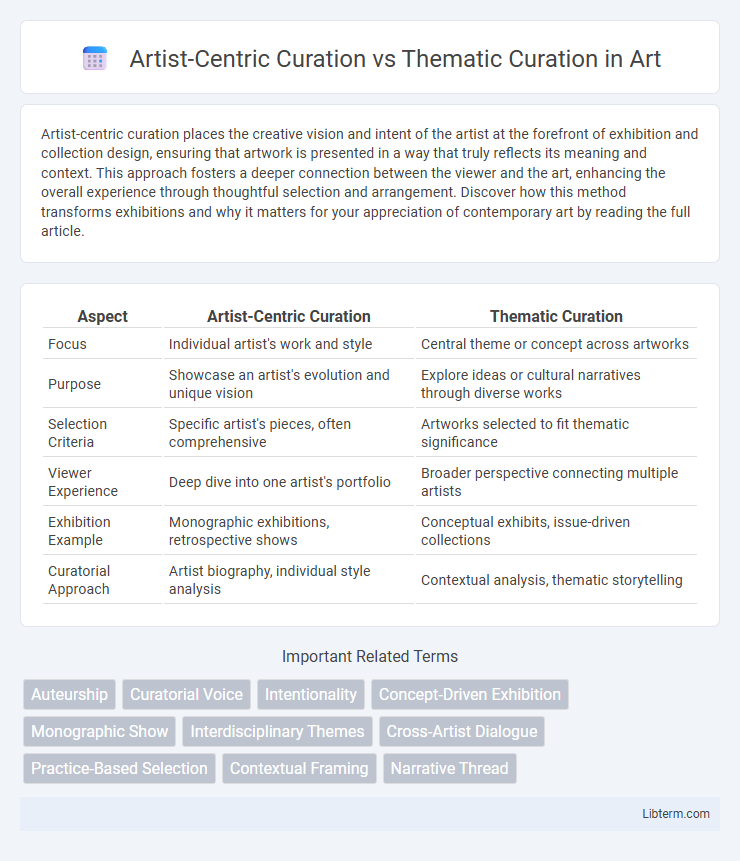Artist-centric curation places the creative vision and intent of the artist at the forefront of exhibition and collection design, ensuring that artwork is presented in a way that truly reflects its meaning and context. This approach fosters a deeper connection between the viewer and the art, enhancing the overall experience through thoughtful selection and arrangement. Discover how this method transforms exhibitions and why it matters for your appreciation of contemporary art by reading the full article.
Table of Comparison
| Aspect | Artist-Centric Curation | Thematic Curation |
|---|---|---|
| Focus | Individual artist's work and style | Central theme or concept across artworks |
| Purpose | Showcase an artist's evolution and unique vision | Explore ideas or cultural narratives through diverse works |
| Selection Criteria | Specific artist's pieces, often comprehensive | Artworks selected to fit thematic significance |
| Viewer Experience | Deep dive into one artist's portfolio | Broader perspective connecting multiple artists |
| Exhibition Example | Monographic exhibitions, retrospective shows | Conceptual exhibits, issue-driven collections |
| Curatorial Approach | Artist biography, individual style analysis | Contextual analysis, thematic storytelling |
Introduction to Art Curation Methods
Artist-centric curation emphasizes showcasing the unique creativity and style of individual artists, highlighting their personal narratives and oeuvre. Thematic curation organizes artworks around a central concept or idea, fostering connections and dialogues between diverse pieces. Both methods play crucial roles in shaping audience engagement and interpretative frameworks within art exhibitions.
Defining Artist-Centric Curation
Artist-centric curation prioritizes the unique vision, style, and creative journey of individual artists by showcasing their complete bodies of work or thematic explorations. This approach highlights the artist's development, techniques, and personal narrative, allowing audiences to engage deeply with their artistic identity. Contrasting with thematic curation, which groups works by common themes or concepts, artist-centric curation centers around the artist as the primary curator of their own expression.
Understanding Thematic Curation
Thematic curation organizes content based on specific concepts or narratives, allowing audiences to explore ideas through a cohesive storyline. It emphasizes context and connections between works, enhancing the interpretation of each piece within a broader framework. This approach contrasts with artist-centric curation, which centers primarily on individual creators and their stylistic evolution.
Historical Context of Curatorial Approaches
Artist-centric curation emerged prominently in the mid-20th century, emphasizing individual artists' visions and biographies to highlight their unique contributions. Thematic curation, gaining momentum in the late 20th and early 21st centuries, organizes exhibitions around ideas, social issues, or cultural narratives, reflecting broader historical and political contexts. These approaches represent evolving curatorial philosophies, from celebrating singular artistic genius to fostering dialogue through interconnected themes.
Benefits of Artist-Centric Curation
Artist-centric curation enhances audience connection by spotlighting individual creators, allowing deeper exploration of their unique styles and artistic evolution. This approach fosters stronger fan loyalty and supports emerging talent by providing focused exposure and a cohesive narrative around the artist's body of work. It also enables galleries and platforms to build distinctive brand identities linked closely to specific artists, boosting market differentiation and engagement.
Advantages of Thematic Curation
Thematic curation offers a cohesive narrative by organizing artworks around specific concepts, periods, or styles, enhancing audience engagement and educational value. It enables deeper exploration of cultural, historical, or social themes, fostering a richer contextual understanding. This approach also attracts diverse audiences interested in particular themes, expanding museum reach and relevance.
Challenges in Artist-Centric Exhibitions
Artist-centric curation faces challenges such as balancing the artist's vision with audience engagement and ensuring a comprehensive representation of their work without thematic restrictions. Limited context may hinder viewers' understanding, risking narrow interpretation compared to thematic curation that offers broader conceptual frameworks. Securing diverse artworks that reflect the artist's evolution while maintaining cohesive exhibition narratives also requires careful negotiation and resource allocation.
Pitfalls of Thematic Curation
Thematic curation often limits artistic diversity by prioritizing concepts over individual artist narratives, which can dilute the depth of personal expression showcased within an exhibition. This approach risks oversimplifying complex artworks to fit a pre-defined theme, potentially marginalizing innovative or non-conforming pieces that don't neatly align. Furthermore, thematic curation may inadvertently promote homogenization, reducing opportunities for unique artist voices to resonate distinctly within the cultural landscape.
Impact on Audience Experience
Artist-centric curation prioritizes individual creatives, creating deeper emotional connections by showcasing artistic evolution and personal narratives. Thematic curation groups works around universal concepts, providing audiences with a comprehensive understanding of a specific idea or social issue. Both approaches shape audience engagement differently: artist-centric methods foster personal discovery while thematic curation encourages reflection on broader cultural contexts.
Choosing the Right Curatorial Approach
Choosing the right curatorial approach between artist-centric curation and thematic curation depends on the exhibition's goals and audience engagement. Artist-centric curation emphasizes the individual vision and style of a single artist, providing a deep dive into their creative evolution and unique contributions. Thematic curation, by contrast, organizes artworks around a central theme or concept, allowing for diverse perspectives and dialogue between varying artists and mediums.
Artist-Centric Curation Infographic

 libterm.com
libterm.com